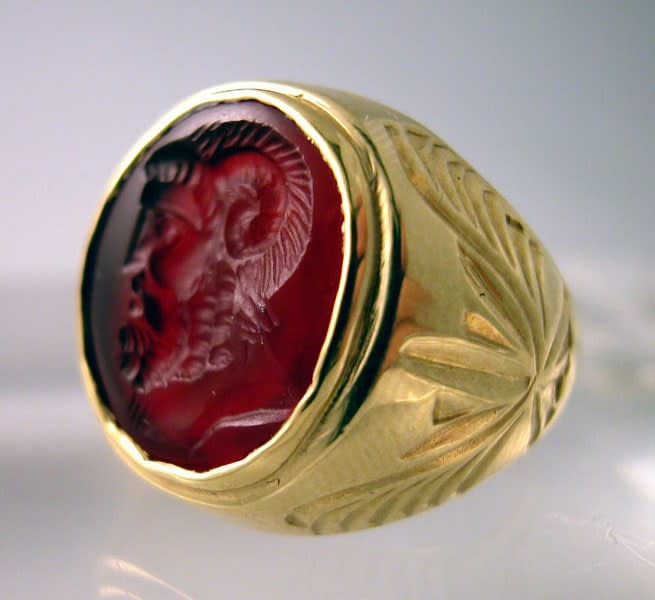Gold Ring with a Roman Carnelian Intaglio Depicting the Bust of Jupiter-Hammon, 100 CE - 300 CE
Gold and Carnelian
FJ.6587
The art of glyptics, or carving on colored precious stones, is probably one of the oldest known to humanity. Intaglios, gems with an incised design, were made as early as...
The art of glyptics, or carving on colored precious stones, is probably one of the oldest known to humanity. Intaglios, gems with an incised design, were made as early as the fourth and third millennia B.C. in Mesopotamia and the Aegean Islands. The exhibit a virtuosity of execution that suggests an old and stable tradition rooted in the earliest centuries. The tools required for carving gems were simple: a wheel with a belt-drive and a set of drills. Abrasives were necessary since the minerals used were too hard for a metal edge. A special difficulty of engraving intaglios, aside from their miniature size, was that the master had to work with a mirror-image in mind.
Jupiter-Hammon was the Roman incarnation of the Ancient Egyptian oracle deity known as Ammon. Originally, Libyan desert tribes worshipped this ram-shaped god at the Oracle of Siwa, an oasis town west of Memphis. Eventually, the Egyptians took over the cult, identifying Ammon with their supreme god Amun. During the Hellenistic era, the cult of Zeus Ammon spread throughout the Classical world. Alexander the Great proclaimed himself the son of Zeus Ammon, and was said to have worn the characteristic horns of his father. During the Roman era, the cult of Jupiter-Hammon remained extremely popular, although the original Oracle was long since forgotten, and spread all the way to the Rhineland. This gorgeous carnelian intaglio seal attests to the popularity of this composite deity during the height of the Roman Empire.
Jupiter-Hammon was the Roman incarnation of the Ancient Egyptian oracle deity known as Ammon. Originally, Libyan desert tribes worshipped this ram-shaped god at the Oracle of Siwa, an oasis town west of Memphis. Eventually, the Egyptians took over the cult, identifying Ammon with their supreme god Amun. During the Hellenistic era, the cult of Zeus Ammon spread throughout the Classical world. Alexander the Great proclaimed himself the son of Zeus Ammon, and was said to have worn the characteristic horns of his father. During the Roman era, the cult of Jupiter-Hammon remained extremely popular, although the original Oracle was long since forgotten, and spread all the way to the Rhineland. This gorgeous carnelian intaglio seal attests to the popularity of this composite deity during the height of the Roman Empire.



